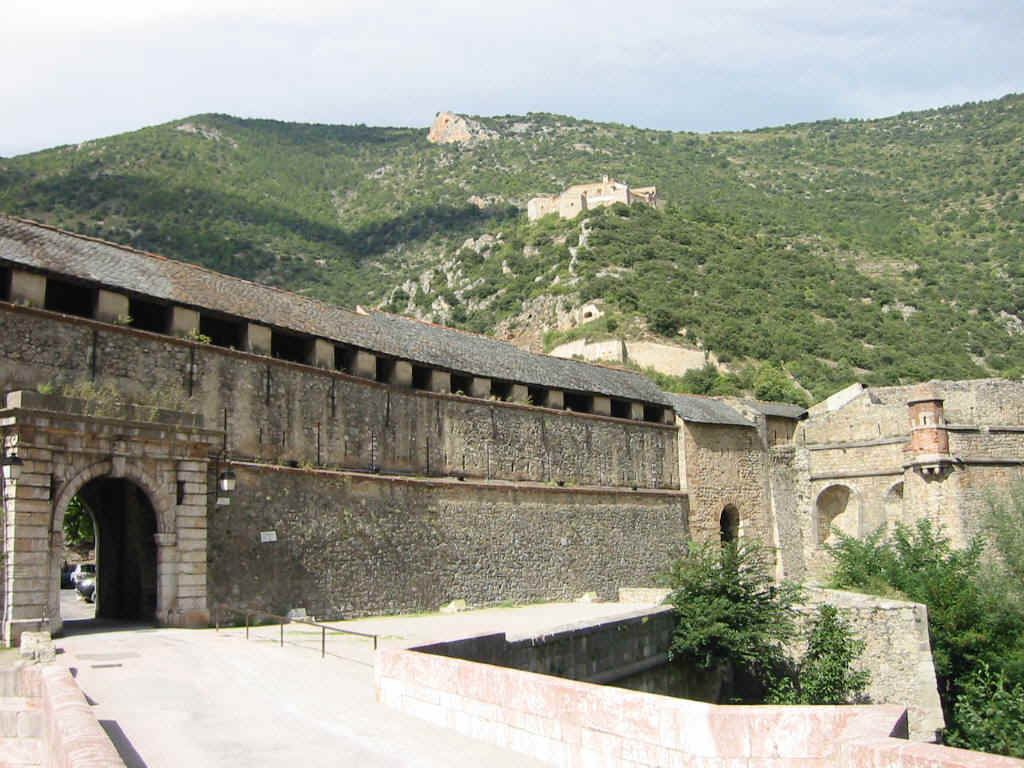
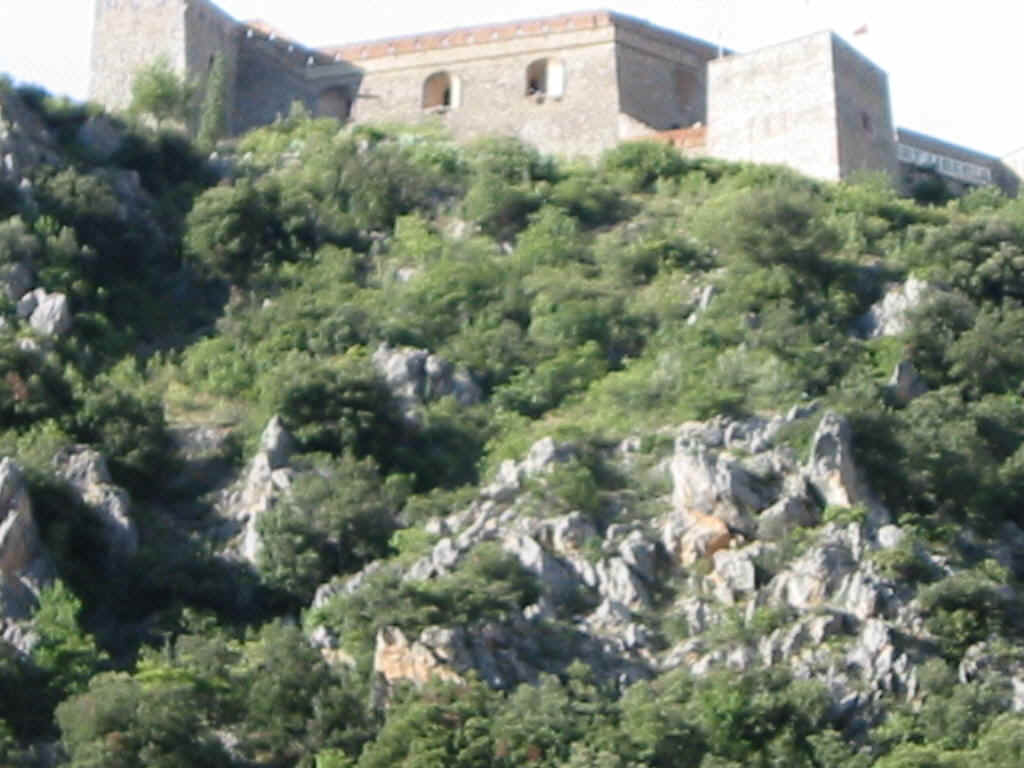
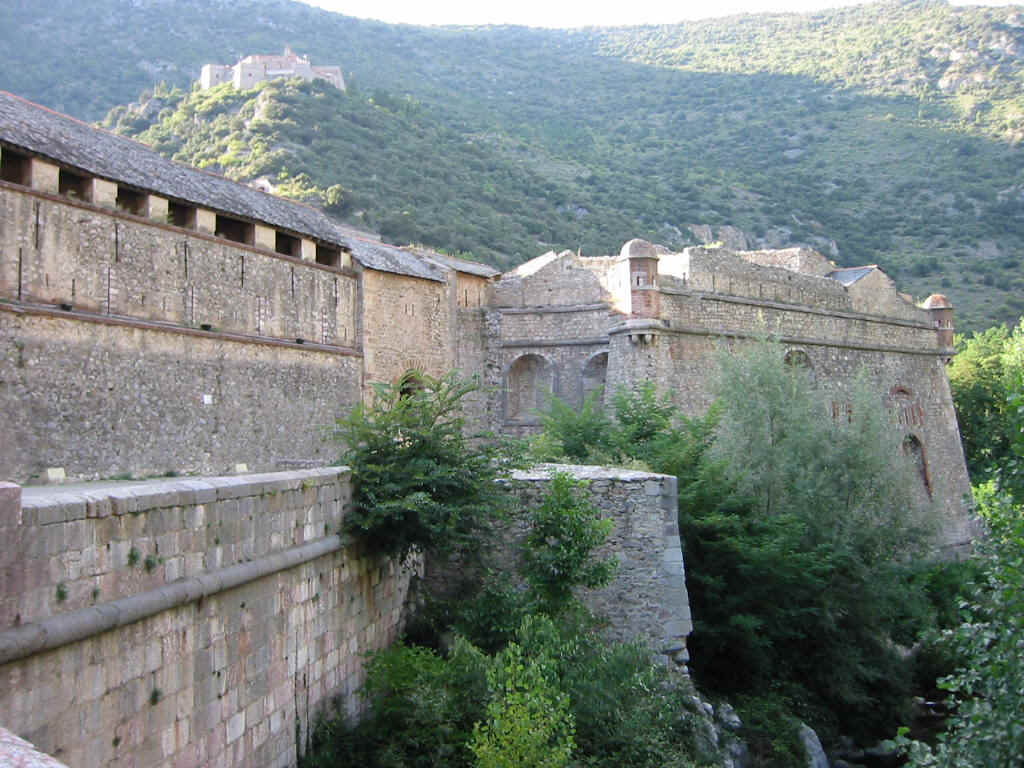
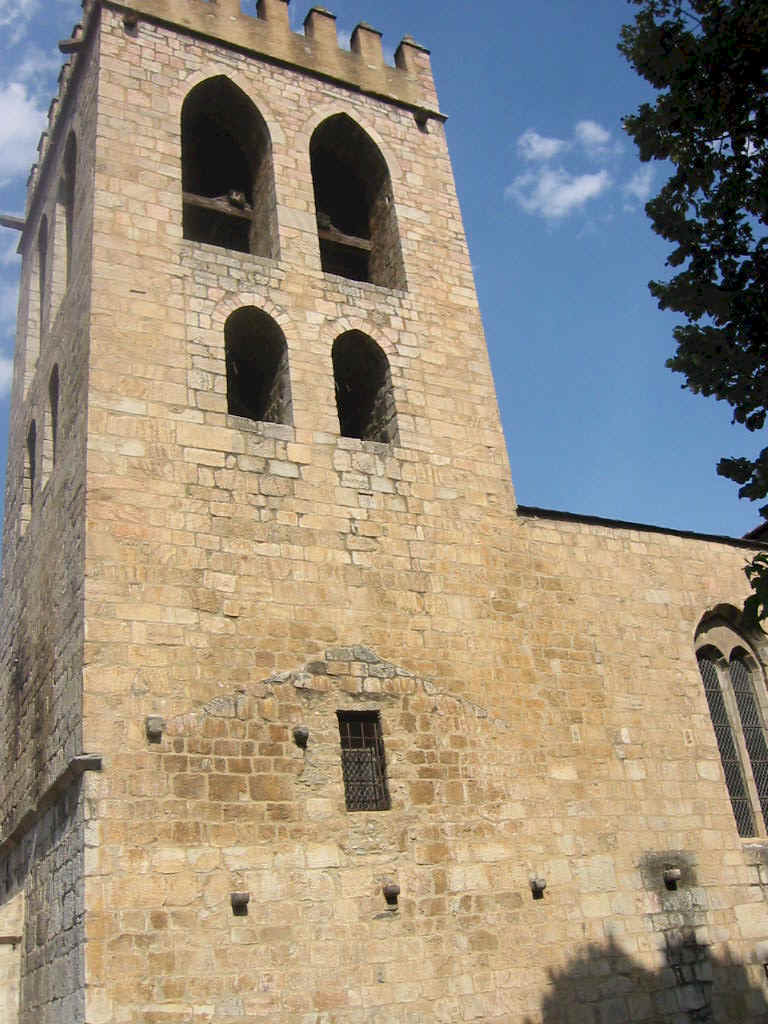
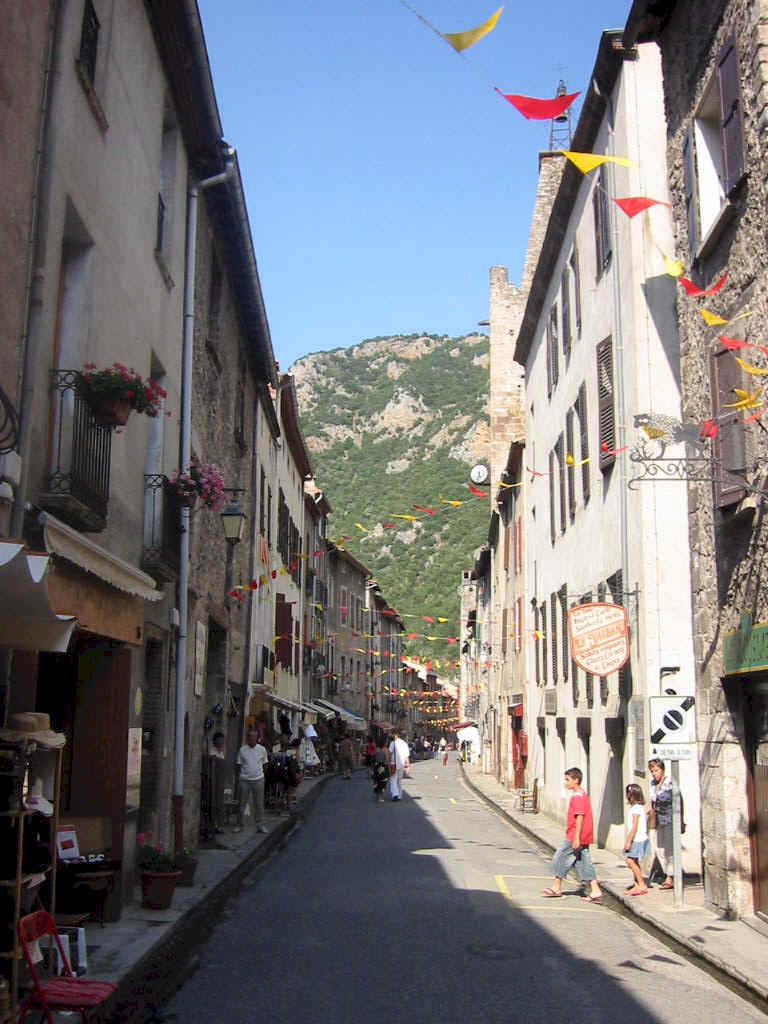
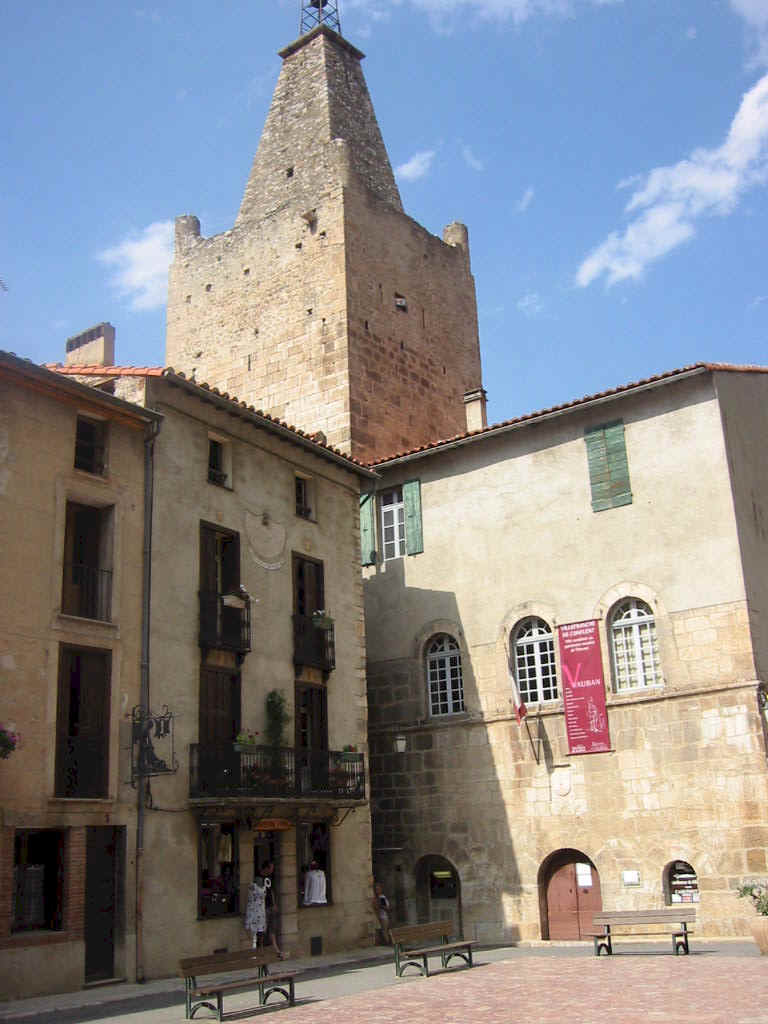
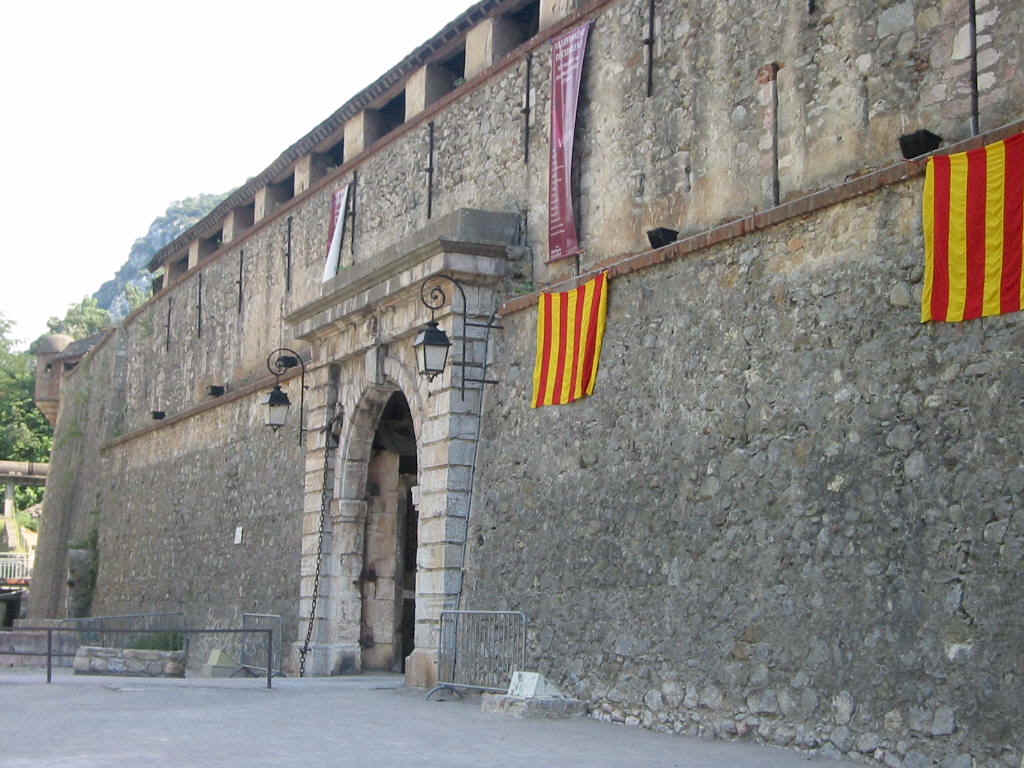
Villefranche de Conflent
Translation and adaptation made from various sources
from French into English
VILLEFRANCHE DE CONFLENT
A medieval garrison town suffering from arrested development, VILLEFRANCHE-DE-CONFLENT, 6km up the Têt from Prades, is a tourist classic and lives off it, but is nevertheless an interesting place. Founded around 1100 by the counts of Cerdagne to bar the road to Moorish invaders, remodelled by Vauban in the seventeenth century after rebelling against annexation by France, its streets and fortifications have remained untouched by subsequent development. Worth a look is the church of St-Jacques, with a primitively carved thirteenth-century baptismal font just inside the door, and you can walk the walls for a fee (daily: Feb, March, Nov & Dec 2–5pm; April, May, Sept & Oct 10am–noon & 2–6pm; June 10am–7pm; July & Aug 10am–8pm; €3.50). If you do so, you'll see why Vauban constructed the Libéria fortress on the heights overlooking the town to protect it from "aerial" bombardment. Getting up to the Libéria (daily: June–Sept 9am–8pm; Oct–May 10am–6pm; €5.34) involves climbing a stairway of a thousand steps beginning just across the old bridge and rail line at the end of rue St-Pierre. If you don't fancy the climb, look for the free minibus leaving from near the town's main gate.
 |
 |
 |
||
 |
 |
 |
 |
|
The tourist office (Feb–Dec daily 10am–12.30 & 2–5.30pm; tel 04.68.96.22.96) is in place d'Église. For accommodation, try Le Vauban (tel 04.68.96.18.03; €30–40; closed Oct–March) next door, or the magnificent old Auberge du Cédre (tel 04.68.96.05.05; €30–40; closed Nov–April; meals from €11.43), situated just east of the old walls.
Villefranche is the terminus for trains from Perpignan. From here up to La Tour-de-Carol on the Spanish frontier, transport is by SNCF bus, or, far nicer, the narrow-gauge Petit Train Jaune, which climbs to the valley head at a pace that allows you a walker's or cyclist's proximity to the scenery, especially in summer when some of the carriages are open-air (late May to Sept 4–6 daily; tel 04.68.96.56.62; €30.20 return). Best of all the frequency of the trains makes it practical to hop off and on, allowing you to explore the areas around the smaller, isolated stations.
THE YELLOW TRAIN
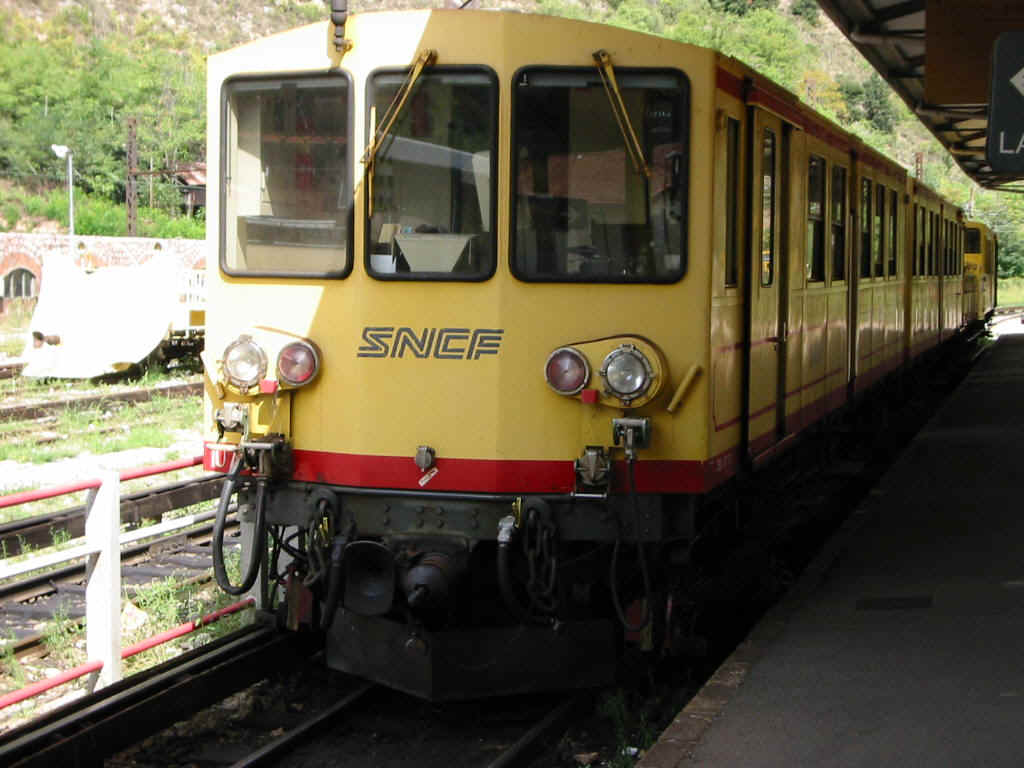 |
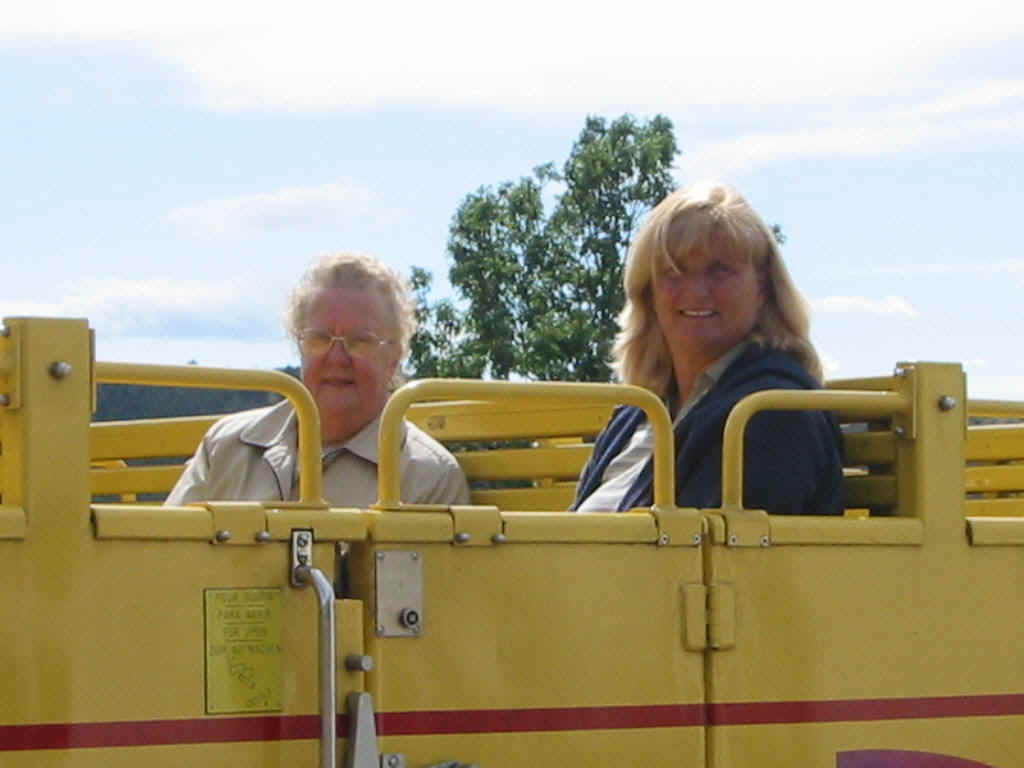 |
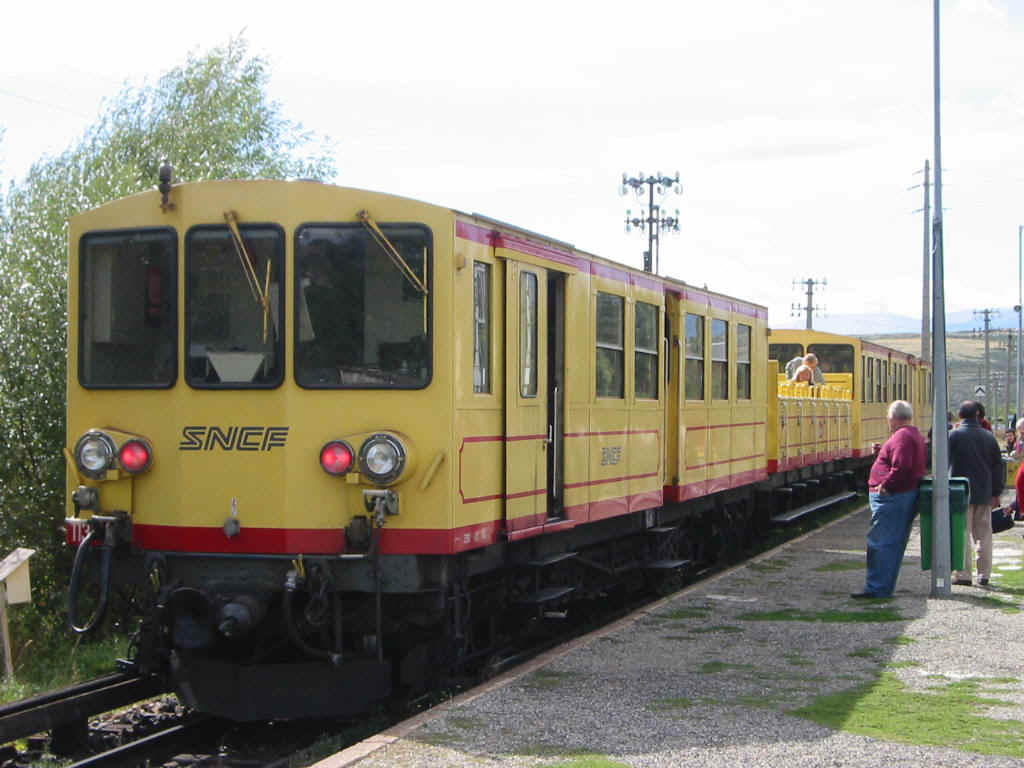 |
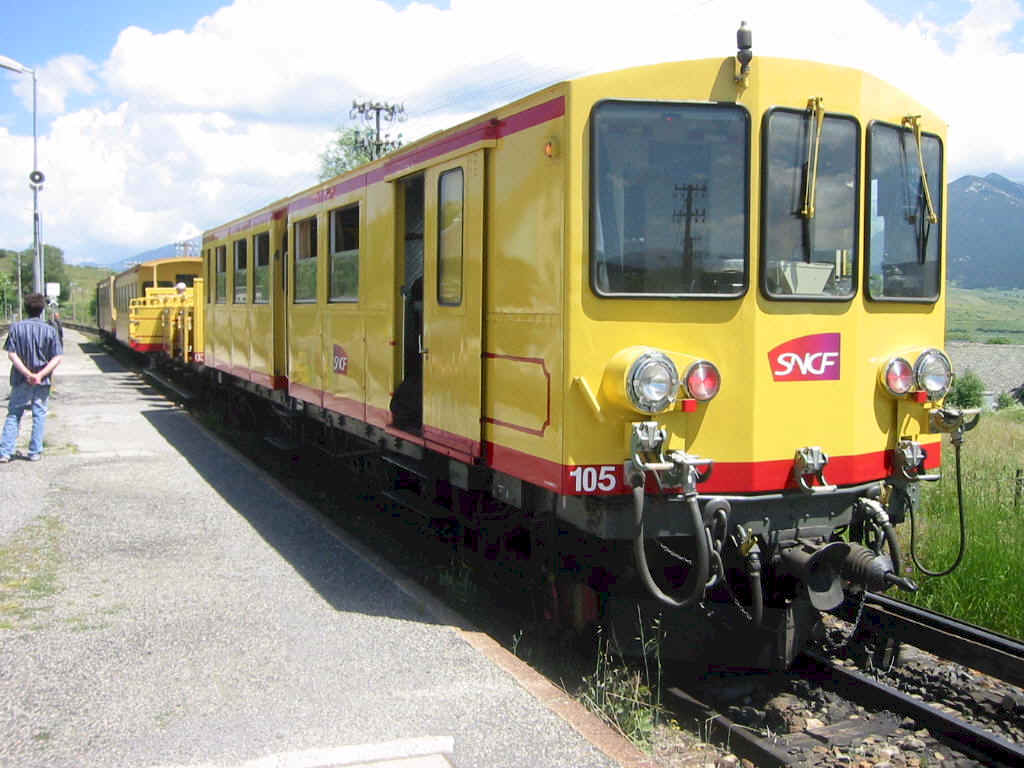 |
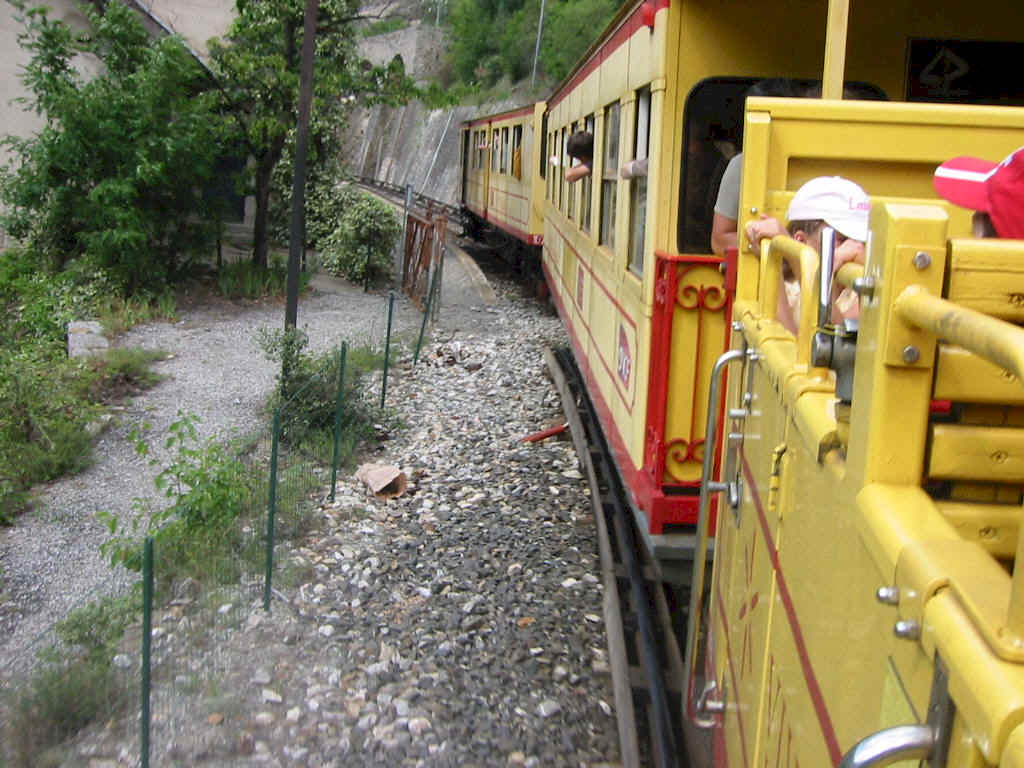 |
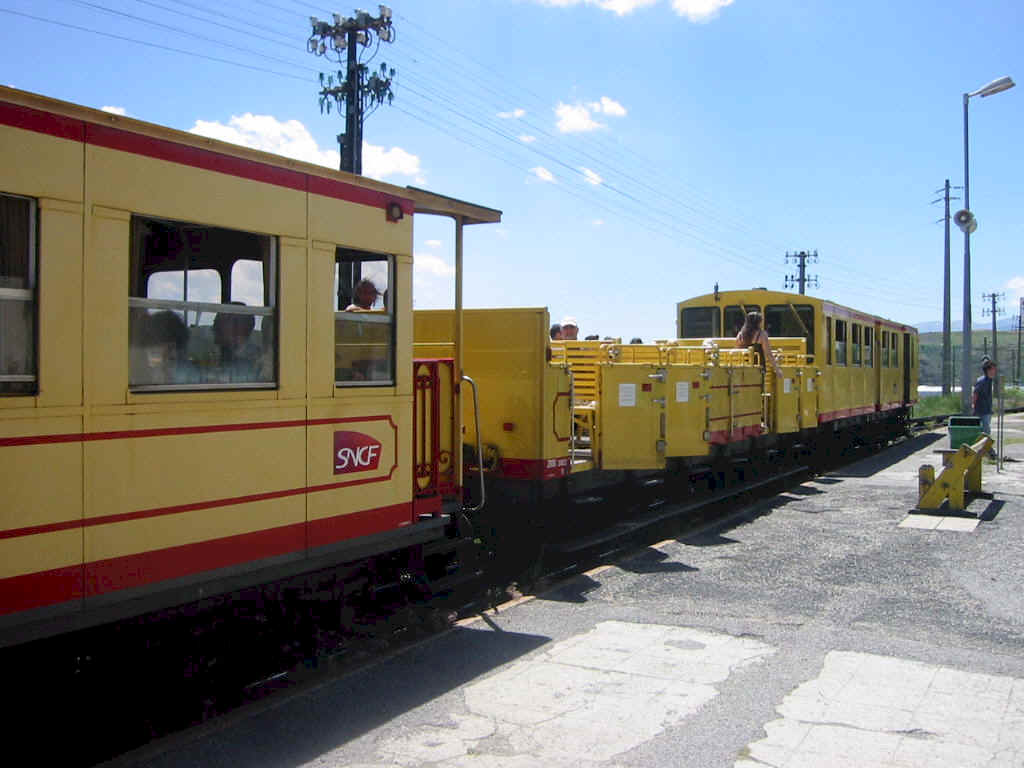 |
The yellow train is also called affectionately: "Canari". It is a real symbol of the Catalan region.
Blood red and gold coloured, it crosses all year long this territory since 90 years. The departure is from Villefranche (427 m), and it climbs up to the highest station of Europe, which is called Bolquère (1 593 m), before joining Latour de Carol Enveitg (1 231 m).
The SNCF keeps, for the greatest happiness of the users, this train that drives in summer as well as in winter and crosses the region of Cerdagne throughout it.
It takes 5 hours and as much for the return, from Villefranche-de-Conflent to the terminus at Latour-de-Carol (64 kilometres at 30 kph).
It is a railway rise through landscapes of mountains, villages like nests in the rocks, torrents, tunnels, viaducts, as well as impressive works of art as the Bridge called Gisclard or the viaduct named Séjourné.
It executes seven go and returns daily.
DEFENDING VILLEFRANCHE-DE-CONFLENT
In addition to strengthening & modernising the town walls of Villefranche, constructing bastions and outworks, Vauban also constructed a detached fort up on Mount Belloc. This was achieved in order both to dominate the town [in the event of it's loss to the enemy or any repeat of the Conspiracy of Villefreanche - see timeline below] and to deny to any enemy the opportunity to do likewise. This very impressive detached work is called Fort Liberia [hereinafter termed "the fort"].
The fort is located on a rather steeply sloped part of the mountain. And in order that it is not dominated from the surrounding ground it is executed on three levels [a fourth was added later at the lower end of the fort]. The fort is therefore significantly higher at it's top end than the lower.
The upper two sections of the fort are shaped like a large broad-beamed ship, with pointed prow & stern. The top section is surrounded by a deep moat. The image on the left shows the exterior of the middle part, the moat & counterscarp are just visible beyond. There is no covered way or glacis extending from the counterscarp [further evidence Vauban was no slave to convention] but it does have a counterscarp gallery allowing the defenders to deliver reverse cross-fire back into the moat. Access to the gallery is gained, ingeniously, via caponniers which truncate each end of the moat and which themselves allow fire to be delivered along the foot of the walls that form the middle & lower portions of the fort.
The fort was bisected at a number of points by high, broad, dividing walls [only one of these remain]. These gave the defenders a chance to contain any enemy encroachment. More importantly, these buttress type affairs - which were a common feature of Vauban's work - provided something of a remedy to the deadly ricochet fire which Vauban himself had invented [whereby a battery would be cited to fire right down the line of a rampart; the charges in the guns being reduced to cause the shot to bounce along it's entire length, smashing everything in the way].
The fort had barrack accommodation for up to 100 men & quarters for the commander of the place and his officers. There was also a bakery, a sizeable water cistern, and even a chapel.
The chapel can be seen on the left from the wall which divides the middle and lower portions of the fort, looking down at the lower part and off towards the very impressive Mount Canigou in the distance.
Vauban was in the habit of designing the buildings that stood within his fortifications in such a way as to remain in keeping with the architecture of the region. Those he designed for Fort Liberia are no exception. They would certainly not offend the aesthetic sensitivities of the Catalans.
The fort had two 12 pounder cannon [poundage = weight of cannon ball fired], two 8pdrs and six 4pdrs, each supplied with 200 rounds of shot. The fort had numerous embrasures for the guns. These were level with the floor of the fort, the parapets were wide enough for soldiers only. Just discernable below are some of the cannon embrasures. These were closed-off with wooden doors when the guns were not being fired.
The fort's magazine held some 12,000 pounds of powder and a sufficient quantity of lead to make all the pistol & musket shot the garrison would require. As stated earlier, each gun was provided with 200 rounds of ammunition. This would have been predominantly solid shot, although there would have been a significant amount of grape shot as well.
The fort was also provided with a quantity of tar [?], and there was a crane for use in mounting cannons on their gun carriages. Finally, the garrison was also equipped with some 36 wall pieces [large calibre wall-mounted muskets] - i.e. in addition to the soldiers' personal weapons.
View from middle section of the fort is the gateway leading to the lower part of the fort. Very near here also, and within the middle portion of the fort, are the staircases that lead down to the capponiers traversing the moat.
VILLEFRANCHE-DE CONFLENT TIMELINE
1090 Villefranche-de-Conflent is founded by Guillaume Raymond, Count of Cerdagne.
1117 Authority over Villefranche passes to the Counts of Barcelona.
1276 Creation of the Kingdom of Majorca [destined to be short-lived]. It's capital is
Perpignan & it's rule extends over Villefranche.
1344 End of the Kingdom of Majorca. Villefranche passes to the Kingdom of Aragon.
1463 Villefranche becomes French for the first time, under Louis XI.
1493 Guardianship of Villefranche passes to the Kingdom of Castille.
1613 Wars of Religion - Villefranche & Perpignan on opposing sides.
1654 Villefranche suffers a six-day siege after which it is captured and then sacked by
the French.
1659 Under the Treaty of the Pyrénées the province of Catalunia is partitioned. France
takes possession of the portion North of the Pyrénées - including Villefranche - and
Spain that to the South.
1661 The French & Spanish hold a conference at Céret to properly delineate their
mutual border on the Pyrénées.
1662 Secret talks between Louis XIV and the Spanish Government, the purpose being to
negotiate an exchange of territory - Spain to acquire Roussillon, & France the Spanish
Netherlands [Belgium]. Nothing comes of the talks.
1663 Renewed hostilities with Spain.
1667 French under Douvrier repulse Spanish raid at Bellegarde.
1669 Vauban makes his first tour of Roussillon; he visits Perpignan, Collioure, Bellegarde
& Villefranche - the last named having recently been designated a permanent garrison
for French troops [projected at 500 in peacetime, 1,500 to 2,000 in times of trouble].
Vauban sets about improving the medieval defences of Villefranche, also drawing up plans
to build a detached fort a short distance to the north of Villefranche, up on Mount
Belloc, to occupy the heights that dominate the town.
1674 As part of a struggle lasting until 1719, some of the inhabitants of Villefranche and
the surrounding region rebel against the French Crown. They seek to be re-united with
their Spanish brethren. In the "Conspiracy of Villefranche", timed to coincide
with a Spanish raid on Bellegarde, Inés de Llar, a young woman of one of the leading
pro-Spanish families seeks to subvert the town's garrison by using her feminine wiles on
the commander De Parlan de Saignes. While de Saignes is unmoved by her advances the town
nevertheless falls to a rebel assault and the garrison massacred. However, before the
rebels can consolidate their gains the crown regains control of the town. Inés de Llar
escapes to Spain but many of her co-conspirators are captured, tried and executed. The
unfortunates' tortured remains are quartered & exposed on the town walls in iron cages
as an example to other would-be rebels.
1679 Vauban's second tour of Roussillon, this time as Commissaire général des
Fortifications.
1680 Vauban makes a third voyage to Roussillon, accompanied by the Chief Minister Louvois.
They visit all the important sites of the region including Villefranche.
1681 Villefranche seemed to some to become secondary to the defence of France with the
inauguration of the fortress of Mont Louis. However, as if evidence were needed of
Villefranche's continued importance, construction of Vauban's detached fort up on Mt
Belloc is commenced.
1687 Vauban makes his last tour of Roussillon.
1707 Vauban dies in Paris.
1793 With the defences in a poor state and with an weak garrison, Villefranche falls after
offering only very limited resistance to an invading Spanish force. Later the same year
the town is retaken by the French under the command of the Sans Culotte General Dagobert
1850 Three year's work begins to link the town's defences with Fort Liberia up on Mt
Belloc. Some 70% of the distance between the two is covered by subterranean works,
including the "stairway of a thousand steps" [734 actually]. An
"Intermediary Battery" is also constructed on the mountain, halfway between town
& fort.
1890 Villefranche ceases to be a garrison town of the French Army
1918 The last detachment of the French Army vacates Fort Liberia.
| Click 4 a Calendar | Click 4 a Currency Converter | Click 4 a Calculator | Click 4 a Translator |
| Home Page - Just4U | Return to Pujol Main Page |